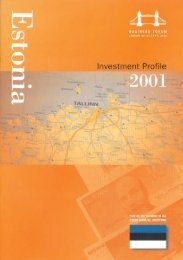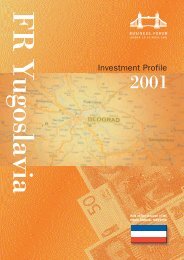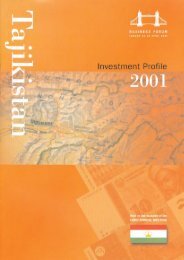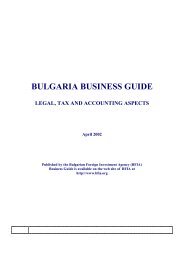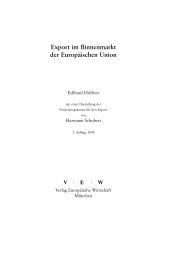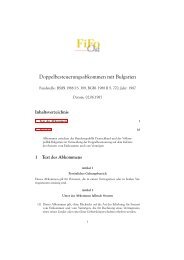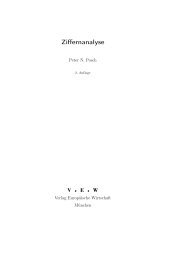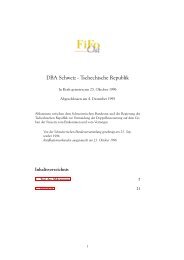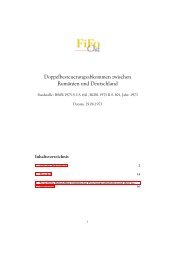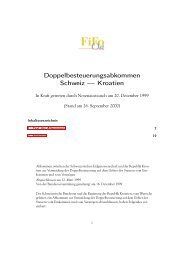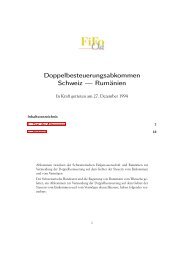EBRD activities in Ukraine - FiFo Ost
EBRD activities in Ukraine - FiFo Ost
EBRD activities in Ukraine - FiFo Ost
You also want an ePaper? Increase the reach of your titles
YUMPU automatically turns print PDFs into web optimized ePapers that Google loves.
Introduction<br />
Major sectors of the economy<br />
Car producer AvtoZAZ <strong>in</strong> Zaporizhzhya recorded losses of<br />
more than US$ 5 million <strong>in</strong> the first half of 2000. In October<br />
the government offered a 31.58 per cent stake for sale,<br />
while reta<strong>in</strong><strong>in</strong>g 50 per cent plus one share until 2004. The<br />
tender failed for a lack of bids. Jo<strong>in</strong>t venture AvtoZAZ-Daewoo<br />
(with Daewoo of Korea), set up <strong>in</strong> 1998 with US$ 300 million<br />
charter capital, was the largest <strong>in</strong>vestment project ever <strong>in</strong><br />
Ukra<strong>in</strong>e, with an estimated value of US$ 1.2 billion. AvtoZAZ-<br />
Daewoo currently operates at 15 per cent of capacity and<br />
assembles Daewoo cars on prepay terms now that<br />
bankruptcy proceed<strong>in</strong>gs have been <strong>in</strong>itiated at the Daewoo<br />
parent company. Although assembly could be suspended,<br />
there are still shipments of Nubira and Legansa component<br />
sets. The jo<strong>in</strong>t venture assembled 12,000 cars <strong>in</strong> 2000,<br />
aga<strong>in</strong>st 6,045 <strong>in</strong> 1999. In 2001 the jo<strong>in</strong>t venture plans to<br />
assemble at least 17,840 cars, 13,340 for domestic<br />
consumption and 4,500 for export. AvtoZAZ-Daewoo is<br />
negotiat<strong>in</strong>g with Russia's AvtoVAZ on long-term cooperation.<br />
AvtoKrAZ (Kremenchuk, Poltava) is one of the largest<br />
producers of heavy-duty trucks <strong>in</strong> the CIS. The company<br />
produces m<strong>in</strong>e dump trucks, onboard vehicles, timber lorries,<br />
truck tractors, concrete mixers, chassis for oil and gas<br />
output equipment and all-terra<strong>in</strong> vehicles for the army.<br />
Currently 50 per cent of shares belongs to the Ukra<strong>in</strong>ian-<br />
German jo<strong>in</strong>t venture Mega-Motors, and 27.33 per cent to<br />
the State Property Fund. AvtoKrAZ <strong>in</strong>creased sales by<br />
69 per cent year-on-year <strong>in</strong> the first three quarters of 2000.<br />
KrimAvtoGaz is a subsidiary of GAZ (Russia) that assembles<br />
cars from components supplied from Russia. The plant has<br />
the capacity to assemble 25,000 Gazelle, Volga and Sobol<br />
cars and trucks a year <strong>in</strong> 60 different modifications.<br />
KrimAvtoGaz assembled 50 per cent more cars <strong>in</strong> 2000 than<br />
<strong>in</strong> the previous year. The company opened the first part of a<br />
new Haden-3 pa<strong>in</strong>t shop <strong>in</strong> December 2000. KrimAvtGaz,<br />
Haden Group International (US) and GAZ are f<strong>in</strong>anc<strong>in</strong>g the new<br />
facility, which will be able to pa<strong>in</strong>t 70,000 cars and trucks a<br />
year. Haden and GAZ are supply<strong>in</strong>g US$ 38 million worth of<br />
equipment. In 2001, the company will <strong>in</strong>crease the share of<br />
Ukra<strong>in</strong>ian parts to 60 per cent from the usual30 per cent,<br />
which will lower the price of vehicles by 15 to 20 per cent.<br />
Energy<br />
Ukra<strong>in</strong>e is a critical transit centre for exports of Russian oil and<br />
natural gas to central and western Europe, as well as a major<br />
energy producer and consumer <strong>in</strong> its own right. Ukra<strong>in</strong>e's energy<br />
18 Ukra<strong>in</strong>e Investment Profile<br />
needs are considerable; it is the world's third largest gasconsumer,<br />
reflect<strong>in</strong>g its fuel-<strong>in</strong>efficient <strong>in</strong>dustry, a legacy of<br />
the Soviet-era. The government's national Energy Programme<br />
up to the year 2010 anticipates greater use of energy sav<strong>in</strong>g<br />
technology and fall<strong>in</strong>g consumption of energy resources, with<br />
overall consumption decreas<strong>in</strong>g from 353 million tonnes of fuel<br />
<strong>in</strong> 1990 to 326 million tonnes <strong>in</strong> 2010. Accord<strong>in</strong>g to this<br />
programme, annual domestically produced fuel resources are to<br />
rise from 179 million to 216 million tonnes. The programme<br />
<strong>in</strong>tends to use foreign <strong>in</strong>vestment to meet at least half of the<br />
country's oil and gas needs. However, Ukra<strong>in</strong>e's energy sector<br />
has been troubled s<strong>in</strong>ce <strong>in</strong>dependence and throughout the<br />
1990s by dependence on barter deals, lack of funds, failed<br />
privatisations, and consumer non-payment, all of which have<br />
contribuFted to a cont<strong>in</strong>ued energy crisis.<br />
Power generation<br />
Thermal power plants account for about 50 per cent of the<br />
electric power produced <strong>in</strong> Ukra<strong>in</strong>e. The country has 17 major<br />
thermal-fired plants with 104 power units. Ukra<strong>in</strong>e has 27 large<br />
comb<strong>in</strong>ed heat and power plants associated with regional power<br />
distribution companies (“Oblenergos”), with 4,014 MW of<br />
<strong>in</strong>stalled capacity. Most of these thermal power plants are old<br />
with obsolete equipment and technology. Although Ukra<strong>in</strong>e<br />
produces more electricity than it consumes, it is not a net<br />
exporter. Much of the electricity the country produces is lost <strong>in</strong><br />
the <strong>in</strong>efficient transmission and distribution network, <strong>in</strong>creas<strong>in</strong>g<br />
dependence on Russian fuel imports. S<strong>in</strong>ce natural gas<br />
accounts for 44 per cent of the primary fuel consumption of the<br />
thermal power plants and 20 per cent of fuel consumption by<br />
all electricity generators, reliance on Russian gas and related<br />
debt problems have affected the electricity sector. Ironically,<br />
Ukra<strong>in</strong>e has enough power plants to produce twice its electricity<br />
needs, but most of them have worked below capacity because<br />
of fuel shortages, caused by the payments crisis.<br />
As part of cont<strong>in</strong>u<strong>in</strong>g <strong>in</strong>ternational support for Ukra<strong>in</strong>e's energy<br />
sector reforms (Task Force on Energy Sector Reform <strong>in</strong> Ukra<strong>in</strong>e),<br />
<strong>in</strong> October 2000 the <strong>EBRD</strong> provided a US$ 100 million Fuel<br />
Purchase Work<strong>in</strong>g Capital Facility as seasonal f<strong>in</strong>anc<strong>in</strong>g for four<br />
state-owned thermal generat<strong>in</strong>g companies. The proceeds were<br />
used to purchase fuel stock (coal and crude oil) for the w<strong>in</strong>ter.<br />
The loan was made on the condition of the successful<br />
fulfilment of the government's immediate reform programme,<br />
which <strong>in</strong>cludes the privatisation of seven Oblenergos and<br />
substantial and last<strong>in</strong>g <strong>in</strong>creases <strong>in</strong> cash collection at all<br />
stages of the power cycle (see Power distribution below).



